You can apply diatomaceous earth wet by mixing 4-6 tablespoons of food-grade DE with water in a spray bottle, shaking thoroughly to eliminate clumps. Hold the nozzle 1-2 inches from surfaces and target cracks, crevices, and pest entry points while avoiding over-saturation. This wet method reduces airborne dust particles, enhances surface adhesion, and allows controlled distribution for better pest control effectiveness. The complete process involves specific timing, safety measures, and monitoring techniques that’ll maximize your results.
What Is Diatomaceous Earth and How Does It Work
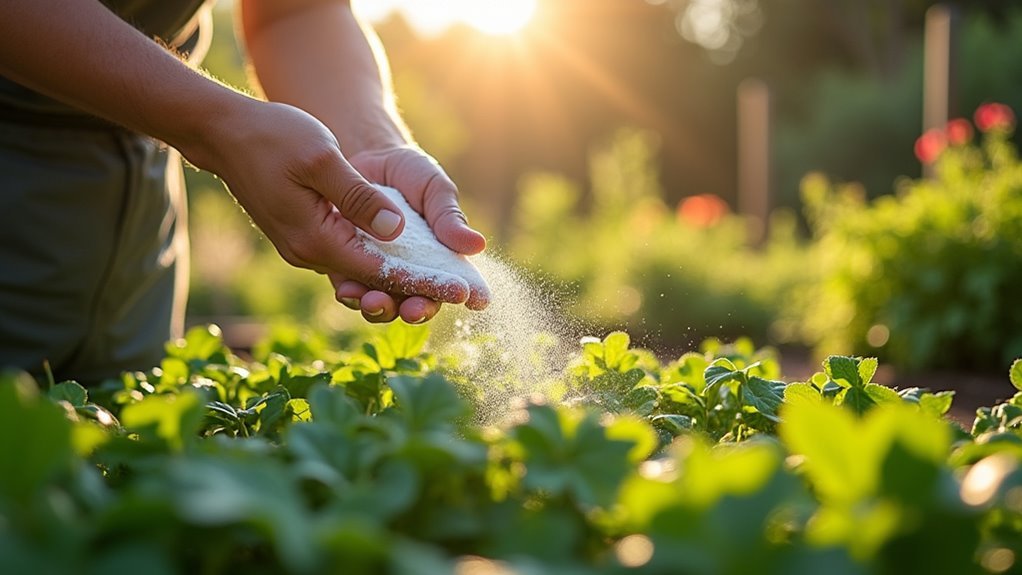
If you’ve ever wondered about natural pest control alternatives, diatomaceous earth offers a powerful solution that’s been hiding in plain sight for decades.
This natural insecticide consists of fossilized remains from microscopic aquatic organisms called diatoms, whose cell walls contain silica.
Diatomaceous earth forms from ancient diatom fossils whose silica-rich cell walls create an effective natural pest control powder.
When you apply diatomaceous earth, its fine particles physically damage insect exoskeletons on contact, absorbing moisture from their bodies and causing dehydration within 24 hours.
This makes it effective pest control against cockroaches, bed bugs, and various other pests.
You’ll find two main types: food-grade DE, which is safe for consumption, and industrial-grade containing higher crystalline silica levels that aren’t safe for ingestion.
Food-Grade Vs Industrial-Grade Diatomaceous Earth
When choosing diatomaceous earth for your specific needs, you’ll encounter two distinct types that differ dramatically in safety and application.
Food-grade diatomaceous earth undergoes rigorous FDA-approved purification, making it safe for human consumption and applications involving food. Industrial-grade DE contains dangerous crystalline silica levels that cause respiratory issues.
Here’s what distinguishes these types:
- Safety Profile – Food-grade diatomaceous earth serves as a non-toxic solution for home use, while industrial-grade requires protective gear.
- Intended Applications – Food-grade works for pest control and dietary supplements; industrial-grade handles filtration and heavy-duty pest management.
- Health Considerations – Only food-grade is safe for human and pet contact.
- Regulatory Status – Food-grade meets FDA standards for consumption.
Benefits of Wet Application Method Over Dry Application

When you apply diatomaceous earth wet instead of dry, you’ll dramatically reduce the fine dust particles that become airborne during application.
This wet method creates better surface adhesion, allowing the DE to stick firmly to treated areas rather than blowing away with the slightest breeze or movement.
You’ll find that wet application gives you more control and precision while protecting yourself and your family from inhaling potentially irritating dust particles.
Reduced Airborne Particles
Since dry diatomaceous earth creates problematic dust clouds that can irritate your respiratory system, wet application offers a safer alternative that keeps particles grounded.
When you mix DE with water, you’ll achieve reduced airborne particles and minimize respiratory irritation that commonly occurs with dry methods.
Here’s how wet application controls particle dispersion:
- Controlled distribution – You can spray the mixture directly onto target surfaces without creating excessive dust clouds during application.
- Enhanced surface adhesion – The wet mixture sticks better to surfaces, making it a more effective insecticide while preventing over-saturation.
- Targeted application – Water keeps particles from dispersing into unintended areas, ensuring precise placement.
- Lasting protection – After evaporation, DE forms an effective dust barrier while maintaining reduced inhalation risks.
Better Surface Adhesion
While dry diatomaceous earth often gets blown away or disturbed by the slightest breeze, wet application creates superior surface adhesion that keeps your pest control treatment exactly where you need it.
The moisture in your mixture activates DE’s natural adhesive properties, allowing it to form a thin, even coating that bonds directly to plant leaves, surfaces, and targeted areas.
This better adherence guarantees you’ll achieve effective coverage without waste or reapplication hassles.
You’ll find wet application particularly valuable for indoor use, where maintaining precise treatment zones matters most.
As the water evaporates, it leaves behind a perfectly positioned layer of diatomaceous earth that won’t shift or disperse, maximizing contact opportunities with pests while maintaining your treatment’s integrity.
Essential Safety Precautions Before Starting
Before you begin applying diatomaceous earth in its wet form, you’ll need to take several critical safety measures to protect yourself and others. These precautions guarantee effective application while minimizing health risks.
- Use only food-grade diatomaceous earth for any application involving human or pet contact to assure safety and avoid harmful industrial-grade products.
- Wear protective gear including a mask and eyewear when mixing or applying to prevent inhalation of fine particles that can irritate your lungs and eyes.
- Verify the application area is dry and warm before spraying to maximize effectiveness and reduce respiratory hazards from airborne particles.
- Keep pets and children away from treated areas until completely dried, and properly dispose of excess diatomaceous earth while cleaning tools thoroughly.
Tools and Materials Needed for Wet Application
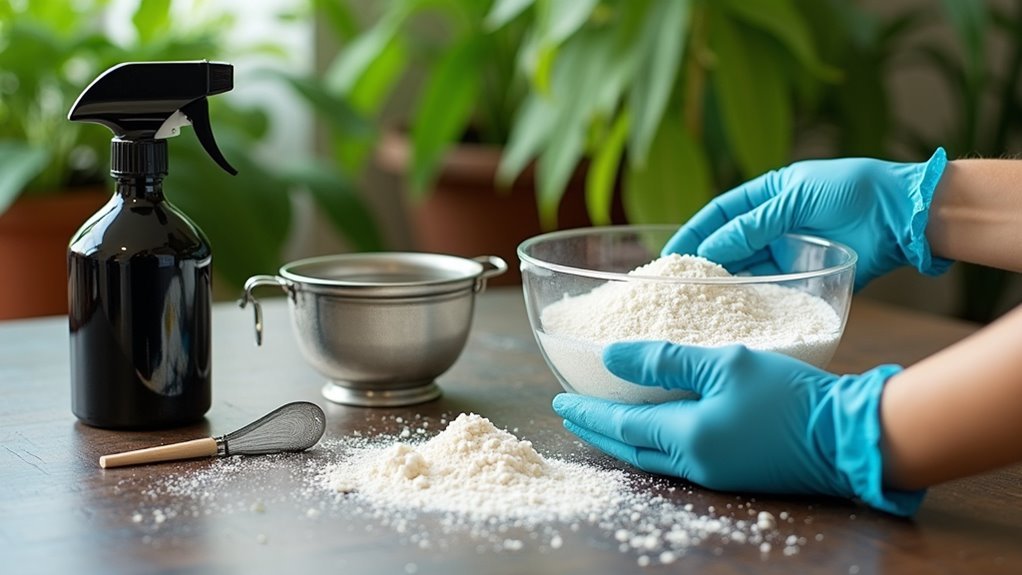
Now that you’ve established the proper safety protocols, you’ll need to gather the right tools and materials to create an effective wet diatomaceous earth application.
Your essential materials include 4-6 tablespoons of food-grade diatomaceous earth and clean water to fill your spray bottle.
For tools, you’ll need a spray bottle as your primary applicator and a funnel for easy filling without spillage.
Keep a vacuum cleaner nearby for post-application cleanup to remove DE residue and dead insects from treated areas.
Choose a warm, dry location for application to guarantee proper water evaporation and maximize DE’s effectiveness.
Having these tools and materials ready beforehand streamlines the process and guarantees you’re prepared for both application and cleanup phases.
Step-by-Step Wet Application Process for Indoor Use
You’ll need to create the right DE solution by mixing 4-6 tablespoons of food-grade diatomaceous earth with water in a spray bottle, shaking thoroughly until well combined.
Focus your application on dry, warm areas where pests are active, holding the nozzle 1-2 inches from surfaces and spraying lightly to avoid over-saturation.
Let the water evaporate completely to form an effective dry layer, then monitor the area regularly and reapply as needed to maintain pest control.
Mixing DE Solution Properly
When mixing diatomaceous earth for indoor pest control, you’ll need to combine 4-6 tablespoons of food-grade DE with water in a spray bottle. This water and spray mixture creates an effective application method that’s easier to control than dry dusting.
Follow these essential steps for mixing DE solution properly:
- Secure the lid tightly on your spray bottle to prevent leaks during the mixing process.
- Shake thoroughly until the DE and water mixture is completely combined without visible clumps.
- Target warm, dry areas in your home where pests are active, as these conditions optimize effectiveness.
- Apply in dry conditions to guarantee the mixture forms a thin layer of dust after evaporation for maximum pest control results.
Target Application Areas
With your DE solution properly mixed, focus your application efforts on specific areas where pests commonly travel and hide.
Target corners, spaces under appliances, and along baseboards where high-traffic areas for insects naturally occur. These locations provide ideal placement for wet diatomaceous earth effectiveness.
When you apply the mixture, hold your spray nozzle 1-2 inches from the surface to guarantee proper coverage.
Create a thin layer across targeted zones, avoiding over-saturation that reduces the food-grade diatomaceous earth’s pest-killing properties. Pay special attention to cracks, crevices, and entry points where insects frequently pass through.
After application, monitor these areas regularly for deceased pests and ongoing pest activity.
This systematic targeting approach maximizes your wet DE treatment’s success while minimizing waste and guaranteeing thorough coverage of problem zones.
Drying and Reapplication
After your wet diatomaceous earth application settles into place, patience becomes essential as you allow the moisture to completely evaporate.
The treated area must dry thoroughly to form an effective protective barrier against pests.
Follow these steps for ideal drying and reapplication:
- Wait for complete evaporation – Don’t rush the process, as any remaining moisture reduces the powder’s pest control effectiveness considerably.
- Monitor for pest activity – Watch the treated area for signs of insects and vacuum up any dead pests to maintain proper hygiene.
- Reapply every few weeks – Fresh applications guarantee continued protection, especially after rain or cleaning that removes the dry coating.
- Choose warm, dry conditions – Timing your reapplication during favorable weather maximizes results and accelerates the drying process.
Outdoor Wet Application Techniques for Gardens and Lawns
Three key factors determine successful wet diatomaceous earth application in your outdoor garden and lawn areas.
First, you’ll mix 4-6 tablespoons of food-grade diatomaceous earth with water in a spray bottle to create your effective insecticide solution. This natural product works best when you apply it during dry, warm conditions to maximize insect control effectiveness.
Second, you’ll spray the mixture evenly on infested plants, concentrating on stems and leaf undersides where pests typically travel. Allow the solution to dry completely, which will apply a fine layer of protective dust barrier against insects.
Third, you must reapply the wet DE mixture after rainfall or heavy watering sessions, as moisture reduces its pest control capabilities and requires fresh treatments for continued protection.
Proper Mixing Ratios and Water Temperature Guidelines
Success in wet diatomaceous earth application depends heavily on achieving the correct mixing ratios and using appropriate water temperatures.
Getting these fundamentals right guarantees your food-grade DE dissolves properly and delivers maximum pest control effectiveness.
Follow these essential mixing guidelines:
- Mix 4-6 tablespoons of food-grade diatomaceous earth per spray bottle of water to create an ideal slurry consistency.
- Use room temperature water to prevent clumping and facilitate smooth dissolution of the DE powder.
- Shake thoroughly before each application to maintain even distribution throughout the solution.
- Apply in thin layers from 1-2 inches away, allowing complete drying for effective evaporation.
These mixing ratios and water temperature guidelines assure your wet application creates the fine dust layer needed for successful pest control.
Target Areas and Pest-Specific Application Strategies
You’ll achieve the best results when you target specific areas where pests naturally congregate and travel through your property.
Focus your wet diatomaceous earth applications on indoor hot spots like baseboards and areas behind appliances, while outdoors you should concentrate on garden beds and entry points around your home’s foundation.
Each pest type requires a tailored approach, so you’ll need to adjust your application strategy based on whether you’re targeting crawling insects, flying pests, or garden invaders.
Indoor Pest Hot Spots
Strategic pest control means knowing where to apply wet diatomaceous earth for maximum impact. These indoor pest hot spots require your focused attention to achieve peak pest control effectiveness.
- Kitchen and bathroom zones – Target these high-moisture areas where pests congregate near water sources and food remnants, ensuring thorough coverage of baseboards and appliance gaps.
- Entry points and thresholds – Apply diatomaceous earth around doorways, windowsills, and utility penetrations where insects enter your home.
- Cracks and crevices – Focus on wall joints, cabinet corners, and floor gaps where cockroaches and ants establish hiding spots.
- Bedroom perimeters for bed bugs – Create protective barriers around bed frames, headboards, and mattress edges to intercept these nocturnal pests effectively.
Outdoor Application Zones
When you move your diatomaceous earth treatment outdoors, you’ll encounter different pest challenges that require targeted application strategies. Focus on outdoor areas where pests congregate: around garden beds, patios, and entry points where ants, fleas, and garden pests commonly appear.
Apply wet diatomaceous earth directly into cracks, crevices, and shaded hiding spots for thorough coverage.
Timing matters greatly for outdoor pest control effectiveness. You’ll achieve best results during dry, warm conditions when moisture won’t immediately compromise the treatment.
Target specific zones based on pest activity you’ve observed, ensuring the wet DE mixture penetrates deep into problem areas.
Remember to reapply after rainfall or watering, as moisture washes away the treatment’s potency.
Monitor treated zones regularly to assess pest activity and determine when additional applications become necessary for maintaining control.
Pest-Specific Treatment Methods
Different pests require tailored approaches to maximize wet diatomaceous earth’s effectiveness in your treatment strategy.
You’ll need to apply this natural pest control solution differently depending on which insects you’re targeting.
- Cockroaches: Apply the wet diatomaceous earth mixture in cracks, crevices, and high-traffic areas, particularly in kitchens and bathrooms where these pests congregate most frequently.
- Garden pests: Spray the solution directly onto affected plants and surrounding soil to create an effective barrier against slugs and snails that damage your vegetation.
- Fleas: Mist pet bedding and resting areas, allowing the mixture to dry into a dust layer that damages fleas upon contact.
- Ants and bed bugs: Target ant trails, nests, mattress seams, and bed frame crevices, ensuring complete drying for maximum effectiveness.
Drying Time and Environmental Factors
After you’ve applied diatomaceous earth wet, the mixture typically requires anywhere from 30 minutes to several hours to dry completely, with environmental factors playing a crucial role in determining the exact timeframe. Temperature and humidity levels directly affect your application’s drying time and overall effectiveness.
| Environmental Factor | Faster Drying | Slower Drying |
|---|---|---|
| Temperature | Warm conditions | Cool conditions |
| Humidity | Low humidity levels | High humidity levels |
| Air circulation | Good ventilation | Stagnant air |
| Surface moisture | Dry surfaces | Damp surfaces |
You’ll want to apply DE during warm, dry conditions for ideal results. Monitor treated areas for complete moisture evaporation before allowing activity or vacuuming. Any visible wet spots must disappear entirely to maintain the DE’s pest control effectiveness, as residual dampness can greatly reduce its performance.
Monitoring Effectiveness and Reapplication Schedule
Once your diatomaceous earth application has dried completely, you’ll need to establish a systematic monitoring routine to gauge its effectiveness against target pests.
Monitoring effectiveness requires consistent observation of treated areas for visible signs of ongoing pest activity.
Here’s your reapplication schedule framework:
- Check within 24-48 hours for dead insects in indoor applications, confirming the diatomaceous earth is working effectively.
- Monitor weekly for new droppings or live insects that indicate continued pest activity in previously treated zones.
- Reapply after moisture events like rain or watering, as wet conditions greatly reduce effectiveness.
- Maintain an application log tracking dates and observed pest activity to refine your control strategy.
Generally, reapplication occurs every few weeks or when you notice pest resurgence in treated areas.
Common Mistakes to Avoid During Wet Application
While wet application of diatomaceous earth can be highly effective, several common errors can undermine your pest control efforts and waste your time and materials.
Don’t oversaturate the area with excessive amounts—a light dusting provides ideal pest control without waste. Confirm the application area is completely dry and warm beforehand, as wet conditions drastically reduce effectiveness against pests.
Avoid moisture-prone locations like basements or near water sources, where rapid degradation occurs. Keep your sprayer nozzle 1-2 inches from surfaces for proper distribution and prevent over-wetting.
After application, allow complete water evaporation before taking further action. The diatomaceous earth should appear as a thin, even layer for maximum effectiveness.
Professional Tips for Maximum Pest Control Results
Beyond avoiding basic application errors, you can greatly boost your wet diatomaceous earth’s pest control performance with strategic techniques used by professionals.
- Perfect your mixture ratio – Use diatomaceous earth with 4-6 tablespoons of food-grade DE per spray bottle. This concentration guarantees effective against pests results while maintaining proper coverage.
- Time your applications strategically – Apply when areas are completely dry and warm. This non-toxic solution for managing pests works best when moisture evaporates quickly, leaving behind active dust particles.
- Master spray distance techniques – Maintain 1-2 inches from surfaces to prevent over-saturation. These application methods help preserve DE’s pest-killing properties.
- Implement monitoring schedules – Check treated areas regularly and reapply after moisture exposure. Consistent use diatomaceous earth applications guarantee continuous pest control effectiveness.
Frequently Asked Questions
How to Apply Diatomaceous Earth Wet?
You’ll mix 4-6 tablespoons of food-grade DE with water in a spray bottle. Apply it 1-2 inches from targeted areas, creating an even layer. Let it dry completely before vacuuming.
Does Diatomaceous Earth Still Work After It Gets Wet?
Diatomaceous earth won’t work when it’s wet because moisture prevents it from dehydrating insects. However, once it dries completely, it’ll regain its effectiveness and continue killing pests until you clean it.
What Not to Mix With Diatomaceous Earth?
Don’t mix diatomaceous earth with oils, greasy substances, wet soil, compost, chemical pesticides, or non-water liquids. You’ll reduce its effectiveness and create clumping issues that prevent proper pest control application.
Do I Need to Wear a Mask When Using Diatomaceous Earth?
You should wear a mask when using diatomaceous earth to prevent inhaling fine dust particles that can irritate your lungs, especially during dry application or in enclosed spaces.
In Summary
You’ll achieve maximum pest control results when you apply diatomaceous earth wet correctly. Remember to use only food-grade DE, mix it properly, and allow adequate drying time. Don’t skip safety precautions like wearing protective gear, and avoid common mistakes such as over-dilution or application during humid conditions. Monitor your treated areas regularly and reapply when necessary. With consistent application and proper technique, you’ll effectively eliminate pests while protecting your family and environment.

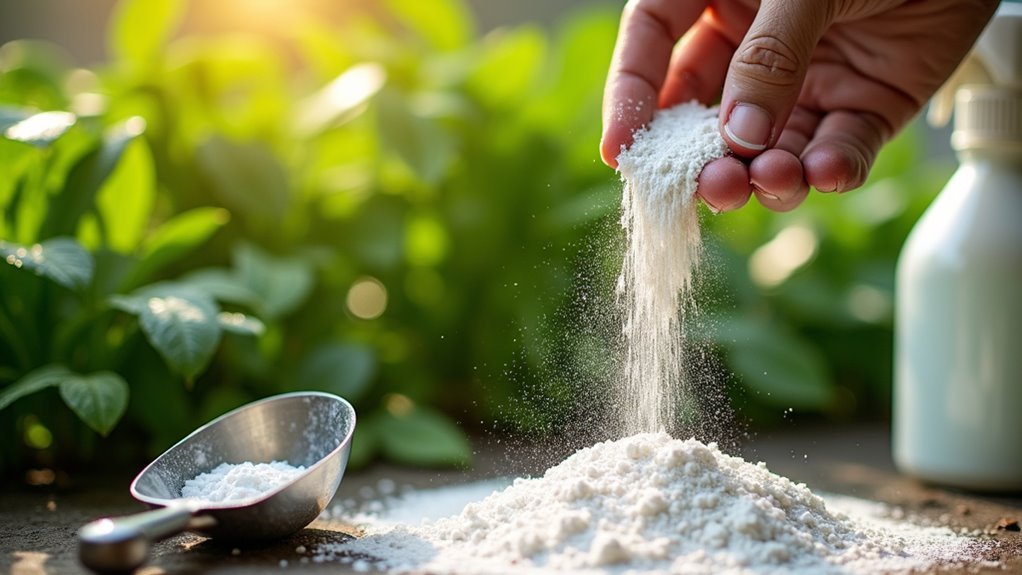
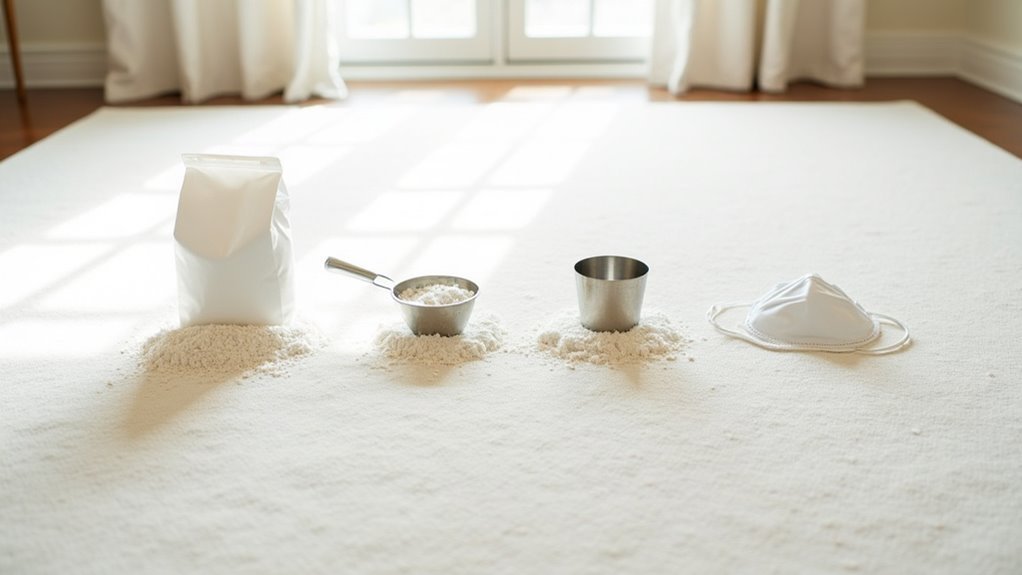
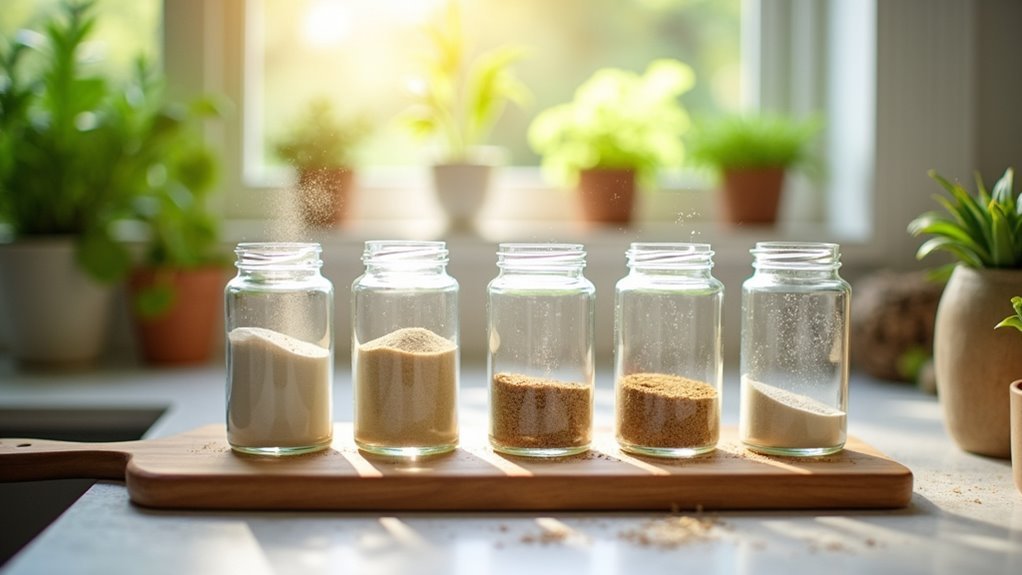
Leave a Reply